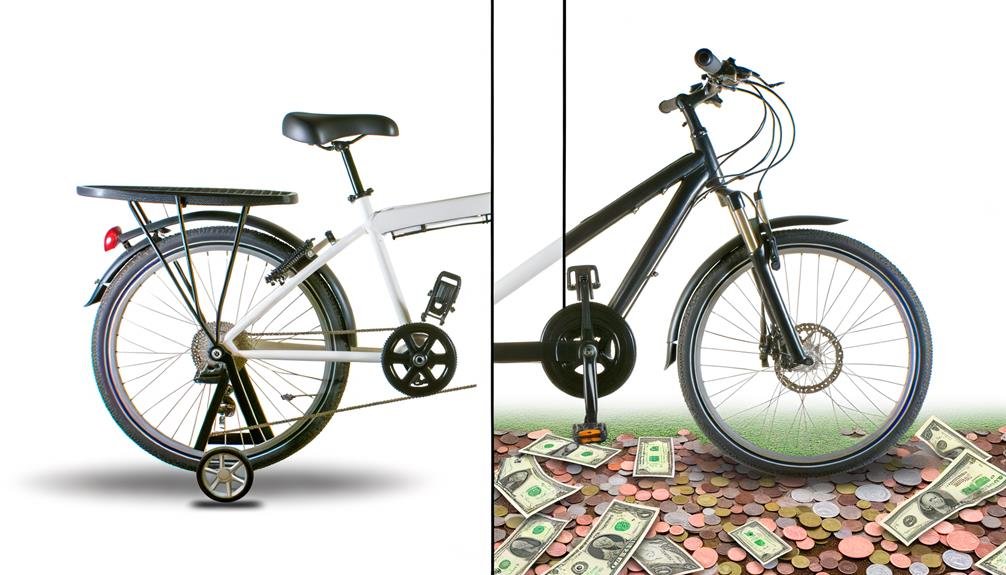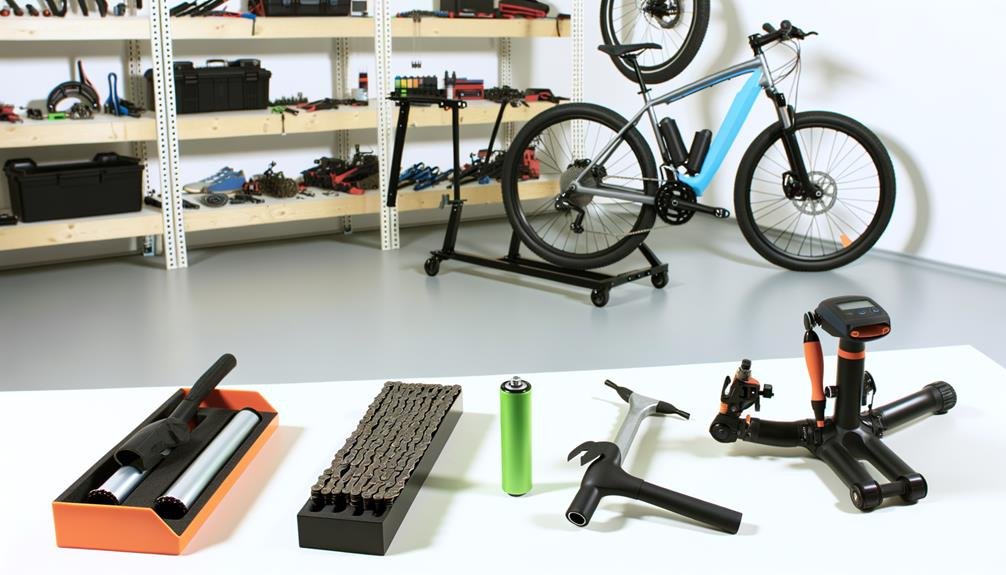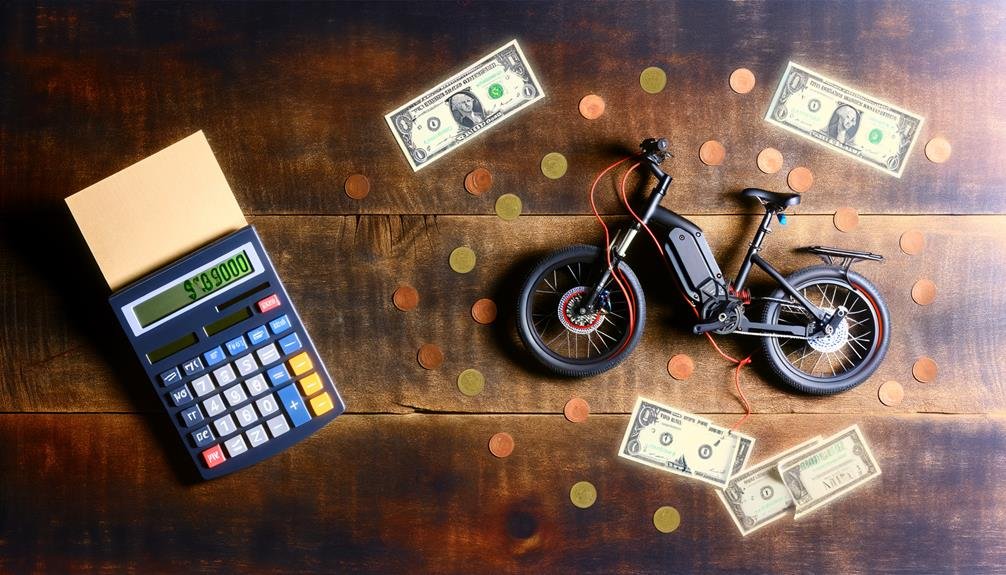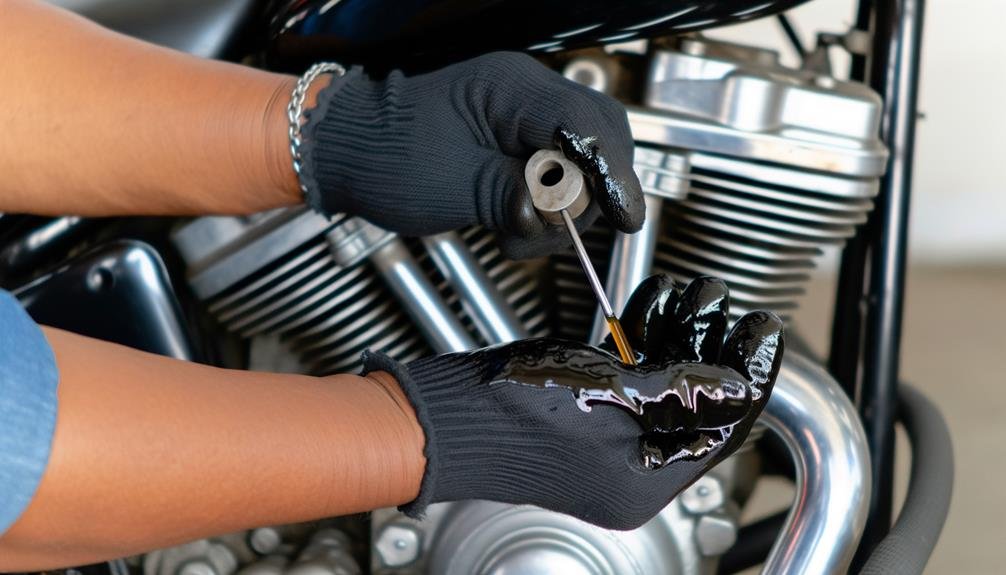Charles Miller is a veteran bike enthusiast with over 12 years of experience dealing with bikes as a mechanic. Despite immense love and expertise for...
Bicycles bring boundless benefits. What if we could boost their utility even further? We're here to discuss the intriguing possibility of transforming a regular bike into an ebike.
This cost-effective concept could potentially propel your pedal-power to new heights, making your commute or casual ride significantly smoother. However, it's not as simple as just slapping on a motor and battery.
As we navigate this nuanced topic, let's dissect the details and determine whether this DIY project is as doable as it sounds. But be warned, there may be more to it than meets the eye.
- Key Takeaways
- Understanding Ebike Conversion
- Evaluating Your Current Bike
- Types of Ebike Conversion Kits
- Step-by-Step Conversion Process
- Cost and Budget Considerations
- Advantages of Bike to Ebike Conversion
- Potential Conversion Challenges
- Legal Considerations for Ebikes
- Maintenance of Converted Ebikes
- Exploring Top Ebike Conversion Kits
- Frequently Asked Questions
- Conclusion
Key Takeaways
- Ebike conversion kits are cost-effective alternatives to buying a new electric bike.
- Compatibility with the bike, budget, motor location, battery type, and wattage rating should be considered when choosing a conversion kit.
- Assess the compatibility of your current bike's frame, forks, rear stays, wheel size, and brakes before choosing a conversion kit.
- There are different types of conversion kits, including front hub motor kits, rear wheel conversion kits, and mid-drive motor kits, each with unique advantages and complexity levels.
Understanding Ebike Conversion
To fully grasp the concept of converting a regular bike into an eBike, it's essential to understand what an eBike conversion entails. An e-bike conversion kit is the magic tool that transforms your regular bike into an electric one. It's a cost-effective way to join the eBike community without shelling out for a brand-new electric bike.
These kits provide an extra power boost, enhancing range, fitness, and efficiency. They're perfect for replacing a car for those quick errands or even for longer commutes. But before you convert a bike, it's crucial to consider a few things. Compatibility with your bike, your budget, the location of the motor, the type of battery, and wattage rating are all factors we need to take into account when choosing an electric bike conversion kit.
Kits like the Swytch eBike Conversion Kit, TongSheng TSDZ2 Mid Drive Motor, and Voilamart 48V Rear Wheel Kit each offer unique features and compatibility. The conversion process involves swapping the tire and tube, attaching the bracket, magnet disc, sensor, and wiring up the motor and battery. Opting for a mid-drive system can make pedalling rather effortless.
Evaluating Your Current Bike
Before diving into the conversion process, it's crucial that we carefully assess our current bike for compatibility with an electric bike conversion kit. Factors such as the frame, forks, rear stays, wheel size, and brakes need to be taken into account. These elements will determine if we can add a motor and which type will be the best e-bike conversion for us.
To make this process easier, let's break it down into four simple steps:
- Determine if your frame, forks, and rear stays have enough space to attach a Mid-Drive Kit or other types of motors.
- Measure your wheel size to ensure it's compatible with the conversion kit.
- Check your brakes to see if they can handle the additional weight and speed of the conversion.
- Lastly, consider your riding habits and preferences to choose a battery capacity that suits your needs.
Keep in mind, transforming a Normal Bike into an e-bike is a practical and cost-effective way to join the e-bike community. So, let's evaluate our current bike properly to make this transition smooth and successful.
Types of Ebike Conversion Kits

When it comes to converting our regular bikes into ebikes, there's a variety of e-bike conversion kits we can choose from, each offering unique advantages and varying levels of complexity.
The first type we'll discuss is the Front Hub Motor Kit with the Bafang front hub motor. This kit includes a motor and battery that is mounted to the front wheel, providing assistance and traction while riding.
The second type is the Rear Wheel Conversion Kit. This drive e-bike conversion kit replaces the rear wheel with a motorized one, offering a straightforward and efficient conversion process.
Lastly, we have the Mid-Drive Motor Kits, like the TongSheng mid-drive. These kits install a motor near the bike's bottom bracket, offering a more natural feel and better weight distribution.
Here's a table summarizing these choices:
| Type | Motor | Advantage |
|---|---|---|
| Front Hub Motor Kit | Bafang front hub motor | Assistance and traction |
| Rear Wheel Conversion Kit | – | Straightforward conversion |
| Mid-Drive Motor Kits | TongSheng mid-drive | Natural feel and better weight distribution |
Step-by-Step Conversion Process
Let's now move onto the heart of the matter – the step-by-step conversion process.
We'll start by guiding you on how to choose the right kit for your bike, taking into account compatibility, motor location, battery type and wattage.
After that, we'll walk you through the installation process and how to test your newly converted e-bike to ensure it's running smoothly.
Choosing the Right Kit
Choosing the right conversion kit for your bike is often the most critical step in transforming a regular bike into an ebike. When choosing the right kit, there are several factors we need to consider:
- Assess Your Bike's Compatibility: Measure your bike's frame, forks, rear stays, wheel size, and brakes to ensure the best electric bike conversion kit fits.
- Determine Your Budget and Needs: Decide on the electric motor's location, battery type, and wattage based on how much you're willing to spend and your riding needs.
- Compare Different Kits: Research and compare various electric conversion kits to find the best fit for your bike and personal preferences.
- Consider Specific Kit Details: Look into the kit's compatibility, motor type, battery options, and installation process.
Choosing the right kit will make your transition from a regular bike into an ebike seamless and enjoyable.
Installation and Testing
With the right conversion kit in hand, we're ready to dive into the installation process, ensuring each component fits perfectly and functions as it should on our bike.
Choosing between a rear or front wheel motor conversion, be it the Swytch system or a Bafang mid-drive, we'll carefully follow the step-by-step guide provided.
We'll securely mount the motor, install the battery, and connect the sensors. But our work doesn't stop there.
Critical to the process is installation and testing. We'll test the functionality of each component, fine-tuning as necessary to ensure the ride quality matches that of the best electric bikes.
It's about belonging to that ebike community, and we're here to make that transition smooth and safe for you.
Cost and Budget Considerations

Before diving into the conversion process, it's crucial that we first take a thorough look at the cost and budget considerations involved in transforming a regular bike into an e-bike. Just like buying a new e-bike, opting to turn a regular bike into an ebike is a financial decision that requires careful thought. It's not just about the upfront cost, but also the ongoing maintenance and potential upgrade costs.
Here are some key cost and budget considerations:
- The price of e-bike conversion kits can vary greatly, from $500 to $2,500, depending on the features and capabilities you want.
- Not all kits come with a battery included, so be sure to check this as it could add to the overall cost.
- Comparison shopping is essential. Research and compare different kits to find the best fit for your bike and your wallet.
- Some kits may only be sold with professional installation included, which could also impact the final price.
Advantages of Bike to Ebike Conversion
Turning a regular bike into an e-bike has several compelling advantages, offering not only an affordable alternative to buying a new electric bike but also opening up new opportunities for fitness, exploration, and customization.
With a bike to ebike conversion, you're able to save money while enjoying the benefits of an e-bike. You'll find the conversion process straightforward and cost-effective, and we're here to guide you every step of the way.
The drive system, battery pack, and pedal assist are key components you'll need to focus on. Whether you choose to attach the drive system to the front or rear wheel is entirely up to you.
This conversion enhances your fitness opportunities, making it feasible to replace car trips with e-bike rides. You'll be able to keep up with faster riders and conquer more challenging terrain, increasing your exploration horizons.
And the beauty of converting a regular bike into an ebike is the freedom it offers for customization. You can select specific components, features, and even the position of the rear wheel, tailoring your e-bike to perfectly suit your needs and preferences.
Potential Conversion Challenges

As we progress in our discussion, it's important to note that converting a regular bike into an Ebike isn't without its challenges.
Technical obstacles can range from compatibility issues with your existing bike to the mechanical competence needed for the conversion.
Furthermore, there are financial considerations to keep in mind, such as the quality of cheaper kits and the potential for increased weight impacting the bike's performance.
Technical Obstacles
Navigating the conversion of a regular bike into an ebike can present a series of technical challenges, chief among them being the compatibility of the conversion kit with your bike's specific components. We need to ensure the kit fits our bike's frame, forks, and most crucially, the rear tyre.
Here are the critical technical obstacles we might encounter:
- Deciding where the motor sits, whether it's a Mid Drive or friction drive system
- Ensuring the e-bike systems like the cadence sensor are compatible with our bike
- Balancing battery life and the wattage rating to match our requirements
- Adjusting to new riding dynamics after the conversion
Understanding these challenges, we can work towards a successful conversion, making our regular bike a part of the ebike community.
Financial Considerations
While overcoming technical obstacles is crucial, we also need to grapple with various financial considerations when converting our regular bike into an ebike.
The system's cost, from a huge range of $250 to $750, is a significant investment. It's also worth noting that some kits mightn't include a battery, adding to the final cost.
Plus, professional fitting services found in Cycling Plus' expert buying guides may be required, potentially inflating the expense.
If you're considering converting rather than buying a brand new ebike, calculate the initial cost, upkeep, and possible warranty issues. Remember, rights reserved, any modifications could affect resale value.
Legal Considerations for Ebikes
Before diving into the conversion process, it's essential we familiarize ourselves with the legal considerations associated with e-bikes. Remember, cycling isn't just about adjusting your rear or replacing the bottom bracket. It's also about respecting regulations and ensuring safety.
When we're talking about turning your regular bike into an e-bike, it's not just about fitting a motor on the front wheel or adding disc brakes. We also need to consider a few critical points to stay on the right side of the law:
- Check local regulations: Does your new e-bike comply with local laws? Are there speed limits or specific paths where e-bikes are allowed?
- Registration and insurance: Some areas require e-bikes to be registered and insured, much like motorized vehicles.
- Class of e-bike: Depending on the modifications, your bike may fall into different classes of e-bikes, each with its own rules.
- Safety standards: Make sure the conversion kit meets safety standards. An England and Wales company, for instance, would need to adhere to specific safety regulations.
Lastly, don't forget your bike's seat post. It's not directly a legal consideration, but ensuring a comfortable ride will help you focus more on observing these regulations.
Maintenance of Converted Ebikes

Now that we've converted our regular bike into an eBike, it's crucial we understand how to maintain it properly.
We'll explore the ins and outs of eBike conversion maintenance, troubleshoot common conversion issues, and discuss the essential tools you'll need.
Understanding Ebike Conversion Maintenance
To ensure the longevity and optimal performance of your converted ebike, it's crucial to regularly maintain specific components. These components include the battery, motor, brakes, wiring, and overall bike structure.
Your regular bike, now enhanced with electric assistance and possibly a Rubbee X device, will need a battery that's well-kept and charged.
Here's a quick guide for your ebike conversion maintenance:
- Regularly check the power output and health of your battery.
- Ensure that the motor is clean and lubricated.
- Keep an eye on the wheel size and brake condition, as the added weight might affect braking efficiency.
- Regularly inspect the wiring to ensure secure connections.
Troubleshooting Common Conversion Issues
Despite the ease of converting a regular bike into an ebike, we may face a few common issues that require troubleshooting to maintain the bike's optimal performance. From the sensor that attaches to the pedal, to the motor, and the battery system, each component needs regular inspection.
Here's a handy table to guide you:
| Issue | Solution | Who to Contact |
|---|---|---|
| Pedal Sensor Misalignment | Re-calibrate sensor | Tech Support |
| Battery Performance Issue | Monitor health, charging cycle | Customer Support |
| Motor Noise or Vibration | Check for debris, misalignment | Tech Support |
Our tech and will always be ready to provide unbiased advice to help you choose the best maintenance practice. Remember, customer support is always available for troubleshooting common conversion issues, ensuring ease of use.
Essential Tools for Maintenance
Maintaining your newly converted ebike requires a set of essential tools for maintenance, ranging from basic bike maintenance items like tire levers, pumps, and an allen wrench set, to specialized equipment such as a multimeter and torque wrench for checking and securing electrical components.
Here's a list to help you feel a bit more prepared:
- Basic Tools: Tire levers, pump, and allen wrench set for routine upkeep.
- Electrical Tools: A multimeter and torque wrench for testing cycling tech, like the LCD display and regenerative braking system.
- Battery Care Tools: Include a battery charger and tester to make sure your battery is always in top shape.
- Cleaning Supplies: Degreaser, lubricant, and brushes for maintaining cleanliness.
Embrace your new ebike journey with these essentials!
Exploring Top Ebike Conversion Kits

Diving into the world of eBike conversion kits, it's crucial to understand the key factors that can influence your purchasing decision. These factors include bike compatibility, budget considerations, motor location, battery type, and wattage rating.
Today's best kits offer a range well beyond the stated 107 miles, but check over 250 million user reviews to ensure you're getting the most bang for your buck.
Exploring top ebike conversion kits, we find the Swytch eBike Conversion Kit, TongSheng TSDZ2 Mid Drive Motor, and Voilamart 48V Rear Wheel Kit as standout options. Each offers unique features, compatibility with different bike models, and varied wattage ratings to suit your needs.
Installation involves replacing the tire and tube, attaching the bracket, magnet disc, and sensor, and wiring everything together. Some kits even offer regenerative braking for an added energy boost.
Keep in mind the latest race content and consider factors like ebike laws and the need for post-installation adjustments to ensure your ride is safe and legal. Remember, your goal is to enhance your biking experience, not complicate it. So choose wisely and happy pedaling!
Frequently Asked Questions
Can a Regular Bike Be Turned Into an Electric Bike?
Yes, we can convert a regular bike into an electric one. We'll gain ebike benefits but face conversion challenges, DIY risks, and require certain tools. Legal considerations, maintenance changes, and performance differences are also important.
How Much Does It Cost to Convert a Bicycle to Electric?
We've found conversion budgeting crucial when transforming a regular bike into an electric one. DIY kits cost between $500-$2,500. Factoring in professional conversion, battery replacement, and maintenance costs, it's a cost-efficient and rewarding endeavor.
Is It Worth Converting a Bike to Electric?
Yes, it's worth it. We obtain conversion benefits like cost savings and enhanced ride experience. Though DIY challenges and legal considerations exist, with proper battery placement and maintenance, we'll overcome hurdles and reap the rewards.
How Do You Convert a Normal Cycle to an Electric Cycle?
We'll guide you through the conversion process. Consider kit selection for compatibility, battery considerations for range, and performance expectations. Remember, maintenance needs and safety precautions are crucial. Enjoy the benefits of your new Ebike!
Conclusion
So, can you turn a regular bike into an ebike?
Absolutely! With the right conversion kit and a little elbow grease, it's a piece of cake.
Remember, where there's a will, there's a way. Converting your bike not only saves you money, but also broadens your biking horizons.
Just be mindful of the legal and maintenance aspects to ensure a smooth ride.
Now, go out there and electrify your cycling experience!

Charles Miller is a veteran bike enthusiast with over 12 years of experience dealing with bikes as a mechanic. Despite immense love and expertise for his Tacoma, he rides his Trek Ebike more. Anytime you meet him, you’ll either hear him talking about Bikes, or writing about all things bikes and cars on this blog.
More Posts


